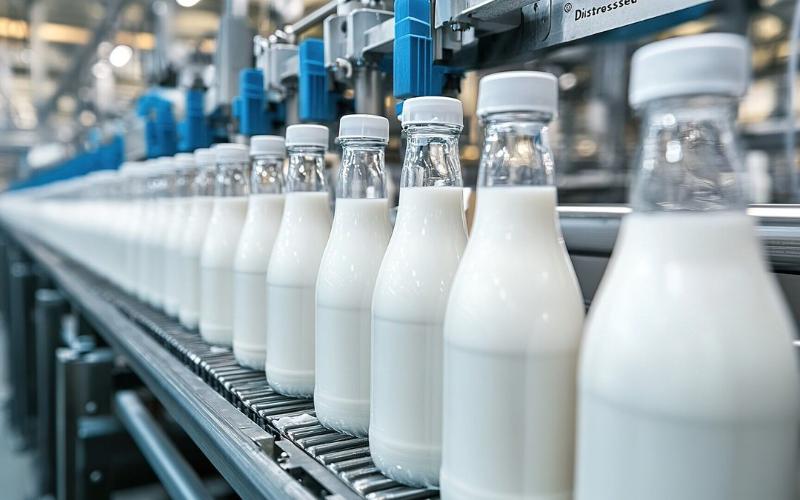USDA Dairy Market Report: Unrest is growing in the European agricultural sector
Source: The DairyNews
Milk production in Western Europe is on the seasonal rise, but winter weather has delayed some deliveries in France and Germany.

Unrest is growing in the European agricultural sector, with protests in Germany over higher taxes on fuel and transportation and reduced agricultural subsidies.
Farmers in France and Belgium are also protesting, citing financial struggles as retailers push prices lower after a period of higher inflation.
Trade talks between the UK and Canada have stalled, as both sides grapple with determining market access for agricultural products post-Brexit.
East Europe:
Milk production in some Eastern European countries continues to grow.
The European Commission aims to balance supporting the Ukrainian agricultural economy while protecting EU member states' markets. Import duties and tariffs on Ukrainian agricultural products into the EU may be extended through June 2025.
Lower-priced grain movement from Ukraine into neighboring states has sparked protests in Poland and Hungary.
Oceania: Australia:
Australian milk production for December 2023 increased compared to the same month in the previous year, with growth observed in every province.
A recent heatwave in Australia raised concerns among farmers about its impact on cows and milk production.
Oceania: New Zealand:
New Zealand's milk production for December 2023 was higher on a tonnage basis compared to December 2022. Total milk solids also increased.
December 2023 export data from New Zealand showed a decline in total dairy export volumes compared to the previous year.
Following GDT event 348, an organization in New Zealand raised its forecasted farmgate milk payout, citing nearly the highest dairy prices in the last year.
South America:
Farmgate milk prices in Brazil are increasing, and seasonal milk output is contracting due to summer temperatures.
Uruguayan milk production continued to increase in late 2023 following improved climatic conditions.
Argentina's late 2023 milk production declined due to less favorable weather and other factors.
Upcoming trade negotiations in South America are expected to take on a different tone due to recent administrative changes in Argentina and upcoming elections in key countries.
National Retail Report:
Conventional dairy ads increased by 12%, while organic dairy ads decreased by 14%.
Cheese is the most advertised dairy commodity, and yogurt slightly edged above ice cream in conventional dairy ads.
Total conventional milk ads decreased by 3%, and total organic milk ads decreased by 43% compared to the prior week.
January Milk Cow Inventory Summary (NASS):
The number of milk cows in the United States as of January 1, 2024, totaled 9.36 million, slightly down from the previous year. Milk cow replacement heifers and those expected to calve during the year also saw slight decreases.
December Agricultural Prices (NASS):
The All Milk price received by farmers in December 2023 was $20.60, down $3.90 from December 2022.
Prices for alfalfa hay, corn, and soybeans also declined compared to December 2022.
The milk-feed price ratio increased to 2.00 in December, up 0.17 from December 2022.
January Final Class and Component Prices (FMMO):
Class prices under the Federal milk order pricing system for January 2024 saw slight changes from the previous month.
Butterfat price for January 2024 is $2.9765 per pound, setting the Class II butterfat price at $2.9835 per pound.
Component prices for protein and other solids for January 2024 set the Class III skim milk price at $4.92 per cwt.
Product price averages for January 2024 include butter at $2.6294, nonfat dry milk at $1.2112, cheese at $1.5226, and dry whey at $0.4338.
Farmers in France and Belgium are also protesting, citing financial struggles as retailers push prices lower after a period of higher inflation.
Trade talks between the UK and Canada have stalled, as both sides grapple with determining market access for agricultural products post-Brexit.
East Europe:
Milk production in some Eastern European countries continues to grow.
The European Commission aims to balance supporting the Ukrainian agricultural economy while protecting EU member states' markets. Import duties and tariffs on Ukrainian agricultural products into the EU may be extended through June 2025.
Lower-priced grain movement from Ukraine into neighboring states has sparked protests in Poland and Hungary.
Oceania: Australia:
Australian milk production for December 2023 increased compared to the same month in the previous year, with growth observed in every province.
A recent heatwave in Australia raised concerns among farmers about its impact on cows and milk production.
Oceania: New Zealand:
New Zealand's milk production for December 2023 was higher on a tonnage basis compared to December 2022. Total milk solids also increased.
December 2023 export data from New Zealand showed a decline in total dairy export volumes compared to the previous year.
Following GDT event 348, an organization in New Zealand raised its forecasted farmgate milk payout, citing nearly the highest dairy prices in the last year.
South America:
Farmgate milk prices in Brazil are increasing, and seasonal milk output is contracting due to summer temperatures.
Uruguayan milk production continued to increase in late 2023 following improved climatic conditions.
Argentina's late 2023 milk production declined due to less favorable weather and other factors.
Upcoming trade negotiations in South America are expected to take on a different tone due to recent administrative changes in Argentina and upcoming elections in key countries.
National Retail Report:
Conventional dairy ads increased by 12%, while organic dairy ads decreased by 14%.
Cheese is the most advertised dairy commodity, and yogurt slightly edged above ice cream in conventional dairy ads.
Total conventional milk ads decreased by 3%, and total organic milk ads decreased by 43% compared to the prior week.
January Milk Cow Inventory Summary (NASS):
The number of milk cows in the United States as of January 1, 2024, totaled 9.36 million, slightly down from the previous year. Milk cow replacement heifers and those expected to calve during the year also saw slight decreases.
December Agricultural Prices (NASS):
The All Milk price received by farmers in December 2023 was $20.60, down $3.90 from December 2022.
Prices for alfalfa hay, corn, and soybeans also declined compared to December 2022.
The milk-feed price ratio increased to 2.00 in December, up 0.17 from December 2022.
January Final Class and Component Prices (FMMO):
Class prices under the Federal milk order pricing system for January 2024 saw slight changes from the previous month.
Butterfat price for January 2024 is $2.9765 per pound, setting the Class II butterfat price at $2.9835 per pound.
Component prices for protein and other solids for January 2024 set the Class III skim milk price at $4.92 per cwt.
Product price averages for January 2024 include butter at $2.6294, nonfat dry milk at $1.2112, cheese at $1.5226, and dry whey at $0.4338.












